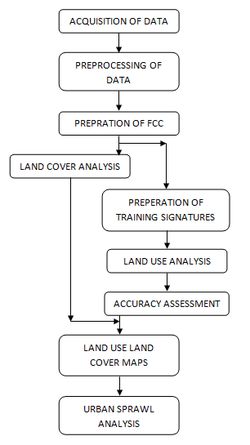|
METHODOLOGY
To understand the temporal dynamics of a region, LULC and Urban Sprawl pattern analysis is necessary; Figure 3 depicts the process followed during the study. Data acquisition includes obtaining data about the region such as the satellite images, Statistics, the ancillary data (Gazetteer, Census), the Maps such as Village maps, District maps. Preprocessing of the data is necessary to remove the haze and other factors through atmospheric correction, removal of Noise and Filling of missing scan lines through radiometric correction. The region of study is then extracted by cropping the processed data. For visual interpretation and for creation of the training sets for classification of the images, a False Colour Composite (FCC) image of the study area is created. FCC is created by composition of band 2 (green), band 3 (red) and band 4 (IR) bands.

Figure 3: Procedure involved in data analysis
Spatio temporal dynamics entails the analysis of multi temporal land use and land cover. Land cover analysis involves the calculation of vegetation indices. Vegetation indices help in mapping of vegetation and non-vegetation. Vegetation Indices are the Optical measures of Vegetation Canopy. Vegetation indices are dimensionless radiometric measurements that indicate the relative abundance and activity of green vegetation; this includes the Leaf area index, percentage green cover, chlorophyll content, and green biomass. The main requirement of vegetation indices measurement is to combine the chlorophyll absorbing (Red Band) spectral region with the non-absorbing (NIR band) spectral region to provide a consistent and robust measure of area under the canopy. The Vegetation Indices algorithms are designed to extract the active greenness signal from the terrestrial land cover. The accuracy of the VI product varies with time, space, geology, seasonal variations, canopy background (soil, water). Among all techniques Normalized Difference Vegetation Index (NDVI) is most widely accepted for land cover mapping. Normalized Difference Vegetation Index is expressed as the ration of differenced in NIR and Red bands to the sum of NIR and Red band. NDVI has the ability to minimize the topographic effect in the region. NDVI ranges between -1 to +1, ration less than 0 i.e., the negative values represent non-vegetation and positive values represent vegetation.
NDVI = 
Land use analysis involves categorizing each pixel in the satellite imageries into different land use themes such as water bodies, vegetation, built up , cultivable land, barren lands, etc.. A multispectral data is useful to perform classification as it shows the numerous spectral patterns/signatures for different features. Spectral pattern recognition refers to the family of classification procedures that utilizes pixel by pixel spectral information as a basis for land use classification. Land use analysis involves collection of training polygons from the satellite imageries and from goggle earth for verification. These training sets were employed for classification of the data into various classes. GRASS GIS, open source software was used for analysis of the data. Land use analysis was carried out using the Gaussians maximum likelihood algorithm.
Accuracy assessment is the process of measuring the spectral classification inaccuracies by a set of reference pixels. One of the most common means of expressing classification accuracy is the preparation of classification error matrix, Error matrices compare on a category by category basis, the relationship between known reference data (ground truth) and the corresponding results of an automated classification.
Urban sprawl analysis through Shannon’s entropy: The Shannon’s entropy (Yeh and Li, 2001, Ramachandra et al., 2012) was computed to detect the urban sprawl phenomenon and is given by,
Hn= −ΣPi log (Pi)
Where; Pi is the Proportion of the urban density in the ith zone and n the total number of zones. This value ranges from 0 to log n, indicating very compact distribution for values closer to 0. The values closer to log n indicates that the distribution is much dispersed. Larger value of entropy reveals the occurrence of urban sprawl.
|



